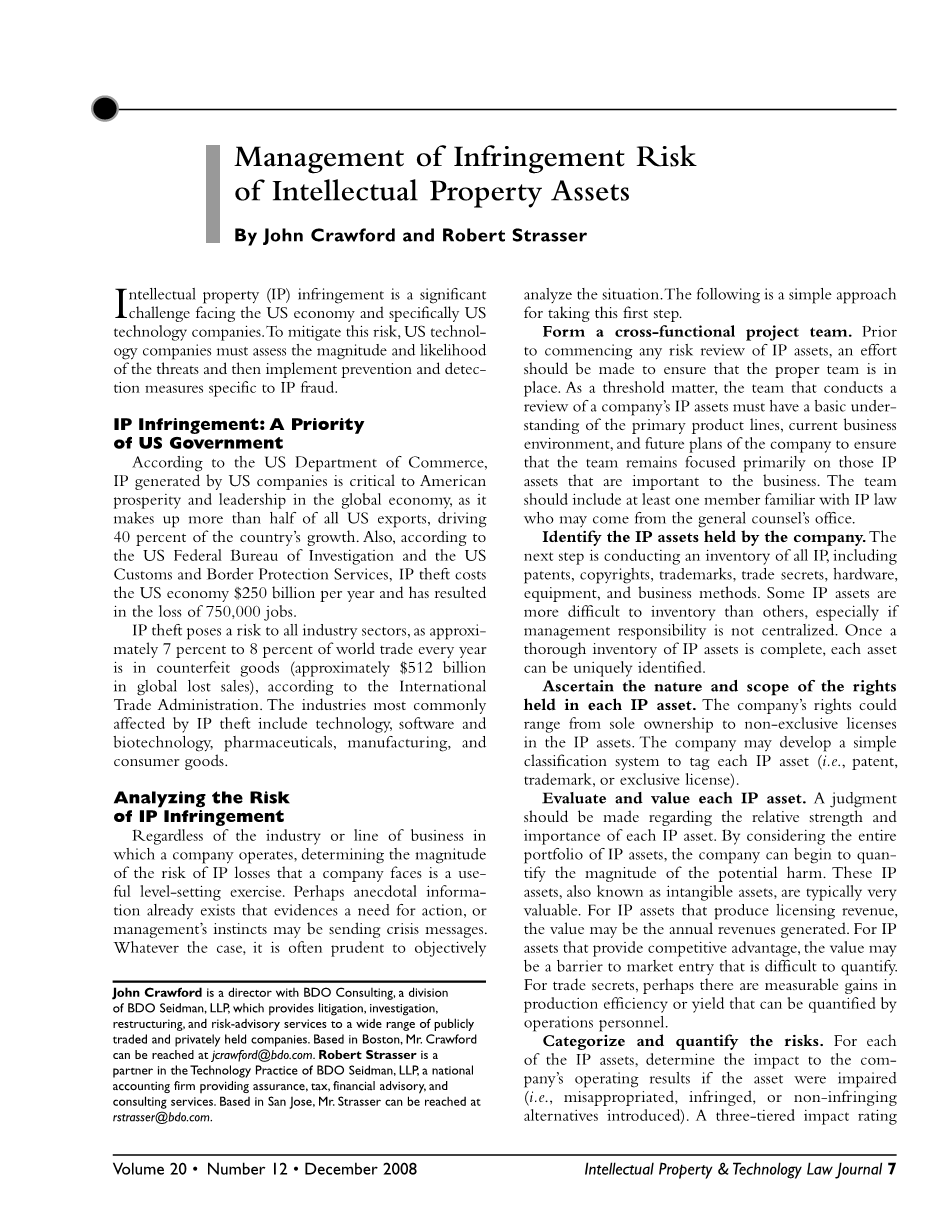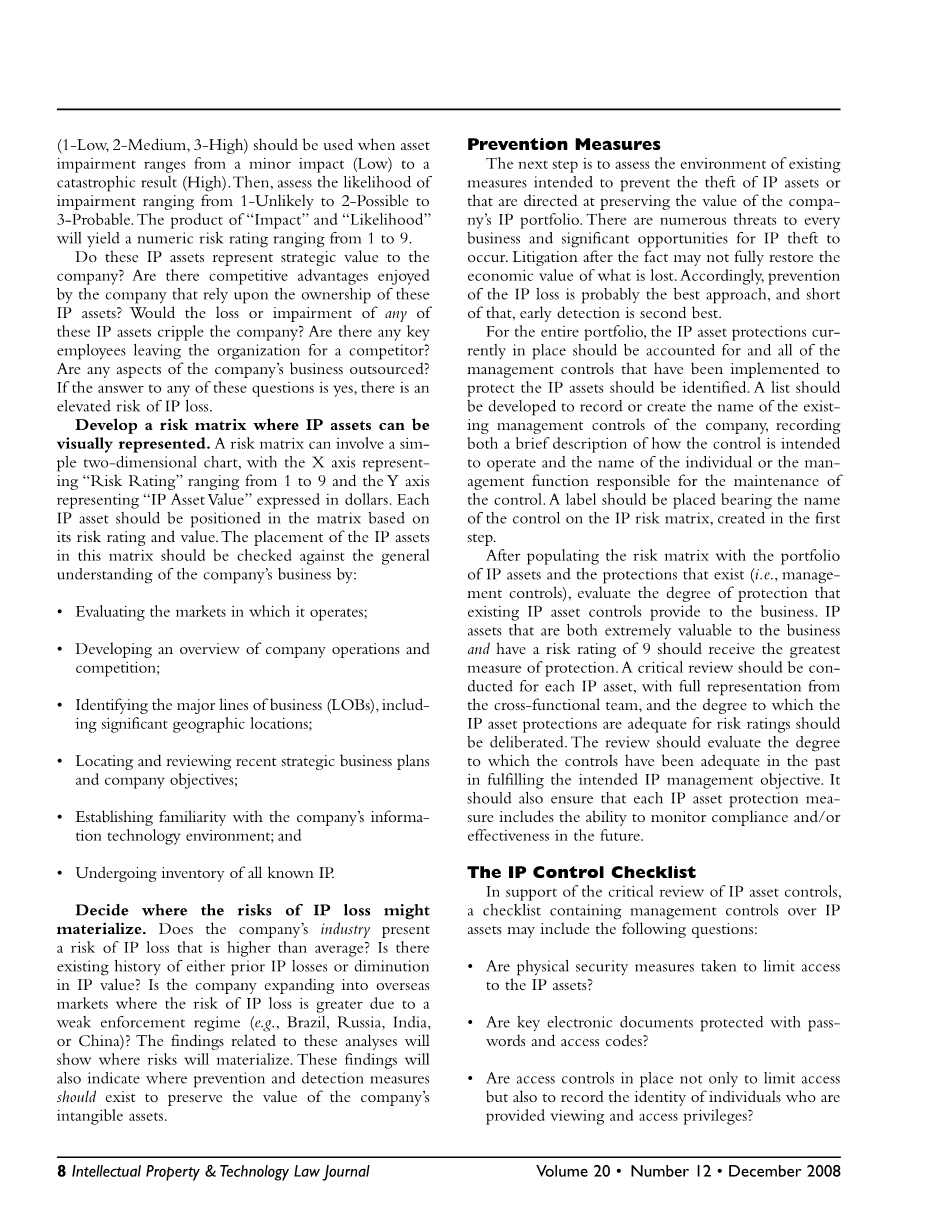“一带一路”战略中知识产权的法律冲突及其解决|外文翻译资料
2022-07-25 14:26:41


英语原文共 5 页,剩余内容已隐藏,支付完成后下载完整资料
Management of Infringement Risk of Intellectual Property Assets
知识产权资产侵权风险管理
John Crawford and Robert Strasser
Intellectual property (IP) infringement is a significantchallenge facing the US economy and specifically US technology companies. To mitigate this risk, US technology companies must assess the magnitude and likelihood of the threats and then implement prevention and detection measures specific to IP fraud.
知识产权侵权是美国经济特别是美国技术公司面临的重大挑战。为了减轻这种风险,美国技术公司必须评估威胁的严重程度和可能性,然后实施专门针对知识产权欺诈的预防和检测措施。
IP Infringement: A Priority of US Government
知识产权侵权:美国政府的优先事项
According to the US Department of Commerce,IP generated by US companies is critical to American prosperity and leadership in the global economy, as it makes up more than half of all US exports, driving 40 percent of the countryrsquo;s growth. Also, according to the US Federal Bureau of Investigation and the US Customs and Border Protection Services, IP theft costs the US economy $250 billion per year and has resulted in the loss of 750,000 jobs.
根据美国商务部数据显示,美国公司所拥有的知识产权对美国在全球经济中保持繁荣和领导地位至关重要,因为它占美国出口总额的一半以上,占全国经济增长的40%。另外,根据美国联邦调查局和美国海关和边境保护服务局的知识产权公布的信息,美国每年被盗窃的知识产权成本损失高达2500亿美元,造成了75万工作岗位的损失。
IP theft poses a risk to all industry sectors, as approximately 7 percent to 8 percent of world trade every year is in counterfeit goods (approximately $512 billion in global lost sales), according to the International Trade Administration. The industries most commonly affected by IP theft include technology, software and biotechnology, pharmaceuticals, manufacturing, and consumer goods.
根据国际贸易管理局的统计,IP盗窃对所有行业构成风险,因为每年世界贸易中有大约7%至8%的是假冒商品贸易(约512亿美元的全球销售损失)。IP盗窃最受影响的行业包括技术,软件和生物技术,制药,制造业和消费品。
Analyzing the Risk of IP Infringement
知识产权侵权的风险分析
Regardless of the industry or line of business in which a company operates, determining the magnitude of the risk of IP losses that a company faces is a useful level-setting exercise. Perhaps anecdotal information already exists that evidences a need for action, or managementrsquo;s instincts may be sending crisis messages.Whatever the case, it is often prudent to objectively analyze the situation. The following is a simple approach for taking this first step.
无论公司所处的行业或经营业务范围如何,确定公司面临的知识产权损失风险的程度是一项有用的标准制定工作。也许轶事信息已经存在,证明需要采取行动,或者管理者的本能可能会察觉危机存在。无论如何,客观的情况分析往往是审慎的。以下是采取第一步措施的简单方法。
Form a cross-functional project team. Prior to commencing any risk review of IP assets, an effort should be made to ensure that the proper team is in place. As a threshold matter, the team that conducts a review of a companyrsquo;s IP assets must have a basic understanding of the primary product lines, current business environment, and future plans of the company to ensure that the team remains focused primarily on those IP assets that are important to the business. The team should include at least one member familiar with IP law who may come from the general counselrsquo;s office.
组建一个跨部门的项目团队。在开始对知识产权资产进行任何风险审查之前,应该努力确保团队的针对性。作为一个门槛问题,对公司知识产权资产进行审查的团队必须对公司的主要产品线,当前的业务环境和未来计划有一个基本的了解,以确保该团队能够以保护公司的知识产权资产为出发点。该团队应至少包括一名可能来自总法律顾问办公室熟悉知识产权法律的成员。
Identify the IP assets held by the company. The next step is conducting an inventory of all IP, including patents, copyrights, trademarks, trade secrets, hardware, equipment, and business methods. Some IP assets are more difficult to inventory than others, especially if management responsibility is not centralized. Once a thorough inventory of IP assets is complete, each asset can be uniquely identified.
确定公司持有的知识产权资产。下一步是制作所有有关知识产权的清单,包括专利,版权,商标,商业秘密,硬件,设备和业务方法。一些知识产权资产比其他知识产权资源更难保存,尤其是在管理责任不集中的情况下。一旦知识产权资产彻底清查工作完成,每项资产都可以被唯一标识。
Ascertain the nature and scope of the rights held in each IP asset. The companyrsquo;s rights could range from sole ownership to non-exclusive licenses in the IP assets. The company may develop a simple classification system to tag each IP asset ( i.e., patent, trademark, or exclusive license).
确定每项知识产权资产所拥有的权利的性质和范围。该公司的权利可以包含从知识产权资产的独占许可权到非独家许可。该公司可以开发简单的分类系统来标记每个IP资产(即专利,商标或独家许可)。
Evaluate and value each IP asset. A judgment should be made regarding the relative strength and importance of each IP asset. By considering the entire portfolio of IP assets, the company can begin to quantify the magnitude of the potential harm. These IP assets, also known as intangible assets, are typically very valuable. For IP assets that produce licensing revenue, the value may be the annual revenues generated. For IP assets that provide competitive advantage, the value may be a barrier to market entry that is difficult to quantify. For trade secrets, perhaps there are measurable gains in production efficiency or yield that can be quantified by operations personnel.
评估每个IP资产并进行估值。应该对每个知识产权资产的相对价值和重要性作出判断。通过将知识产权资产进行整合,公司可以开始量化潜在危害的程度。这些IP资产,也被称为无形资产,通常是非常有价值。对于能产生许可收入的知识产权资产,其价值可能会产生固定的年收入。对于提供竞争优势的知识产权资产,其价值可能表现为难以量化的市场准入门槛。对于商业秘密,也许可以由运营人员通过生产效率的提高和产量的增长来进行量化。
Categorize and quantify the risks. For each of the IP assets, determine the impact to the companyrsquo;s operating results if the asset were impaired ( i.e., misappropriated, infringed, or non-infringing alternatives introduced). A three-tiered impact rating (1-Low, 2-Medium, 3-High) should be used when asset impairment ranges from a minor impact (Low) to a catastrophic result (High).Then, assess the likelihood of impairment ranging from 1-Unlikely to 2-Possible to 3-Probable. The product of “Impact” and “Likelihood” will yield a numeric risk rating ranging from 1 to 9.
风险分类和风险量化。,如果资产受到损害(即被盗用,侵权或非侵权的替代方案),则应该确定每个知识产权资产对公司经营成果的影响。 当资产减值范围从轻微影响(低)到灾难性结果(高)时,应使用三级影响评级(1低,2中,3高)。 然后,评估从1-不太可能至3-可能发生的减值的可能性。 “影响”和“可能性”的结果将产生从1到9级的风险等级。
Do these IP assets represent strategic value to the company? Are there competitive advantages enjoyed by the company that rely upon the ownership of these
全文共24155字,剩余内容已隐藏,支付完成后下载完整资料
资料编号:[144973],资料为PDF文档或Word文档,PDF文档可免费转换为Word
课题毕业论文、开题报告、任务书、外文翻译、程序设计、图纸设计等资料可联系客服协助查找。



